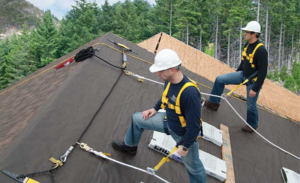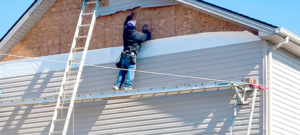Your roof is one of the most important aspects of your home. If yours needs replacement, it can be a complicated project to manage.
A good Ellingson Roofing LLC contractor will follow several meticulous steps to replace your roof. These steps are outlined below:

Permits
One of the most important first steps in a roof replacement is obtaining any necessary building permits from your local municipality. This ensures that your contractor is working within the guidelines of your area’s zoning laws, and will help avoid any potential headaches down the road if the city finds out you haven’t followed the proper process for getting a permit.
The next step is the roof inspection and planning stage, where your roofing contractor will take a close look at your existing roof. This will include a visual inspection of the structure, as well as an interior inspection to assess any potential water damage that may have occurred over time.
After the inspection, your roofing contractor will give you a cost estimate for the roof replacement and provide you with a timeline of when the work will begin. This is a good opportunity to discuss your preferences for the new roof, including the type of material and color. Your roofing contractor will also ask about any special needs your roof might have, such as skylights or solar panels.
During this phase, your roofing team will set up your job site. This will involve covering plants, furniture, and other things that could be damaged by falling debris. Then, your roofing team will begin the tear-off of your old roof. This includes tearing off the old shingles and underlayment down to the roof deck.
Your roofing crew will then remove the old materials and haul them away to be disposed of properly. Most of the materials will be recycled, and some may even be used in future roof projects. The rest will be taken to a special construction dump, which is specifically designed to handle all the different materials used in the roof construction industry.
Once the old materials have been removed, your roofing contractor will inspect the roof deck to make sure it is in good condition. If any areas are weakened or cracked, they will be repaired to provide a stable base for the new roof.
Before the roof removal begins, it is a good idea to clear out your attic and move any items that are stored there to another location. The hammering involved in the roof removal can cause vibrations that might knock things off your walls, so it’s best to move any decorations or other fragile items ahead of time.
Setup
When homeowners decide to replace their roofs, they often have many questions about the process. While it may seem like a big task, a professional roofing contractor will help you every step of the way to ensure a smooth and efficient process. We’ll discuss why you might want to replace your roof, how the process works, and what you can expect from start to finish.
The first step in the roof replacement process is to remove the existing roof. This is a messy and time-consuming part of the job, but your contractor will take multiple precautions to protect your property. They’ll cover sensitive areas of your home and yard with tarps, and use wooden boards to protect things like your garden and air conditioning unit. They’ll also have a dumpster delivered to dispose of the old materials and coordinate the delivery with the tear-off so that they can begin loading your new roof right away.
Once the old shingles are removed, the contractor will inspect and clean the gutters to make sure they’re free of debris. They’ll also blow out any vents on your roof and install a new metal drip edge at the bottom of the roof to prevent water damage. Next, they’ll install a layer of starter shingles on the edges of your roof to provide extra strength and protection where wind and weather tend to do the most damage.
After that, the main shingles will be installed on your roof. They’ll be overlapping each other starting at the eaves and moving toward the peaks. The shingle tabs will be staggered and covered with a sticky adhesive to prevent water from seeping in between them. Finally, the peaks and rake ridges will be capped with specialized ridge vent shingles for additional protection from rain and wind.
Then, the contractors will clean up the entire area around your home. They’ll put the tarps back down and roll them up, and they’ll also have a magnet to pick up any stray nails in your yard. They’ll also clean up any materials that have been tossed into your driveway and garage. This is a crucial step to ensure that your home is protected during the replacement.
Removal Of Existing Roof
If you’re replacing an old roof, the first step is removing the existing one. Many roofing contractors recommend doing a full tear-off of the existing roof, instead of re-roofing over the top. Re-roofing is an option, but it won’t give you the same benefits of a new roof, such as boosted energy efficiency and enhanced curb appeal.
Before beginning the actual work of tearing off an old roof, the contractor will cover bushes and shrubbery that could be damaged by falling debris with tarps. They will also place tarps on the ground to protect areas where they’ll be working, such as around the chimney. They’ll then install their roof jacks, and attach a 2×10 board to help prevent the shingles from sliding off the roof. It’s best to complete this part of the job during clear weather, as it will be easier and faster – not to mention less risky.
Once the roof jacks are in place, your roofing contractor will begin to remove the shingles from the roof in 2- or 3-foot sections. They’ll start with the ridge caps, which are the shingles at the peak of the roof. They’ll work their tool under the shingles, and then pry them loose to let them slide down onto the roof jacks. Once the shingles are removed, the roof deck will be exposed.
The roof deck will be inspected for any damage that may impact the new roofing system, including wood rot or mold growth. The contractor will then sweep the roof, and if necessary, use a power washer to remove any remaining debris.
A small amount of the sheathing may need to be replaced, depending on how old it is and whether or not any areas have been impacted by storms. This is where it becomes crucial to get the right professional on the project, as they’ll know exactly what materials are required and how to replace them.
The remaining pile of shingles and roof components will be hauled away and disposed of. This is a messy process, but it’s necessary to ensure that the new roof is installed in a clean and pristine environment.
Installation
Replacing your roof is a major project that will be a huge disruption to your daily routine and will take up a lot of time. However, it is important to replace your old and worn roof to avoid further damage to your home and escalating costs.
The installation phase will begin after the roofing contractor has made sure that all the necessary permits have been obtained and that the property is safe for construction. Then, they will cover any parts of your yard or garden that are not directly under the roof with tarps and a dumpster will be brought to collect the old material. Then the roofing crew will start the process of removing your old shingles or tiles. The roofers will also inspect the roof deck for any areas that need to be repaired or replaced.
Once all the old materials are removed, a new layer of underlayment will be added to the roof deck before the new shingles or tiles are laid down. It is vital to ensure that the underlayment is fully watertight before the new shingles or tiles are placed on top, as this will prevent any leaks and protect the structure of your roof for many years to come.
After the underlayment has been installed, the roofing crew will install the new shingles or tiles on your roof. Depending on the type of roof you have, this could be a variety of different types of asphalt shingles, metal tiles, or even wood shakes and slate. The new shingles or tiles will be attached using a strong adhesive, and the edges of your roof will be sealed to protect the interior of your house from rainwater and wind-driven debris.
Finally, the gutters will be cleaned out to remove any shingle or tile debris and the flashing around your chimney, vents and other features of your roof will be replaced as needed. It is essential to use high-quality flashing, which is typically aluminum or galvanized steel, to avoid any water leaks in the future.
The length of time it takes to complete the roof replacement will vary depending on a few factors, such as the size of your roof and the type of new roof you have. The roofing contractors will let you know when the job is scheduled to be completed, and they will work hard to complete the job as quickly as possible to minimize any inconvenience to your home life.


